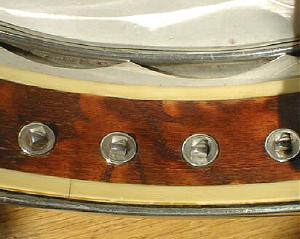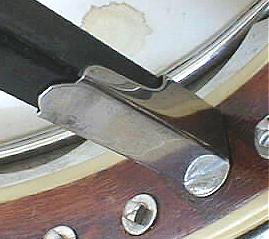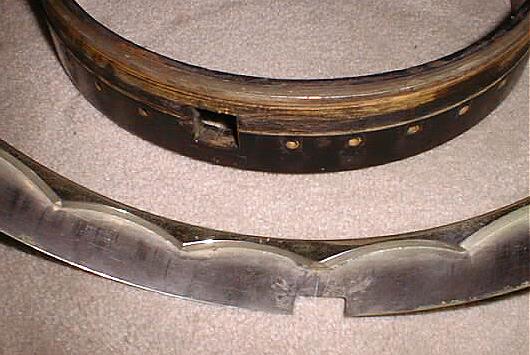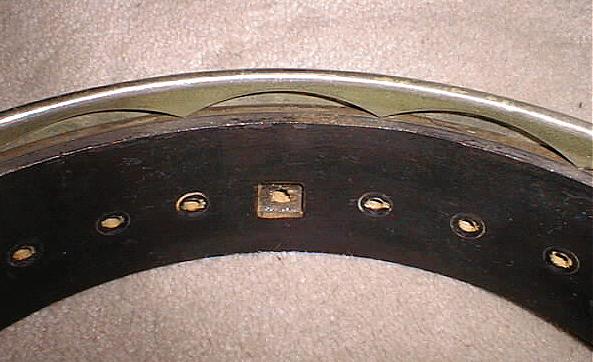Fairbanks Banjos
Construction & Tone Rings

A.C. Fairbanks Co. (1895-1900)

1895 was a highly significant year in the evolution
of
Fairbanks banjos.
A.C. Fairbanks left the company to pursue other
interests
and it was taken
over by David Cummings and Frank Dodge with former
office
boy David Day as manager.
Day was a tremendous innovator and rapidly changed
the
appearance and nature
of Fairbanks banjos. The Fairbanks stamp on the
dowel stick was replaced with the
familiar metal tag shown above. The bracket shoe
style of neck brace was replaced
with the 3-point horseshoe style and a decorative
ferrule
was added to the end of the dowel stick.
The Electric tone ring become much more substantial
with
the original 1/8" diameter
upper ring replaced with a 1/4" diameter ring, the
wooden
pot becoming thicker,
and the scalloped ring much heavier.

The mother of pearl inlays on the peghead and
fingerboard
became much more complex
and exhibited the Victorian style and taste then
popular.
Around 1895 an interesting variation of the Electric
tone
ring appeared.
It consisted of a half spun wooden pot, the metal
sheath
on the upper outside surface
extending only about halfway down to the brackets, with
an "inverted" scalloped tone ring structure.
This inverted tone ring was made as one solid piece
rather
than of separate scallops, hoop and sheath.
The downward reaching points rested on a 3/16" square
steel hoop inset into the outer top edge of the pot.
This variation was frequently called the Imperial
Electric
Examples of the following models remain:
From 1895:
Fairbanks & Cole
Electric, Imperial Electric, No.3 Electric
Columbian, Senator, Regent
No.0 Special
- + -
From 1896:
Imperial
Fairbanks & Cole
Electric, No.00 Electric, No.1 Electric, No.3 Electric
Imperial Electric, No.0 Imperial Electric
Curtis Electric, Special Electric
Senator, No.1 Senator
No.1 Special, No.2 Special, No.3 Special
- + -
From 1897:
Fairbanks & Cole
Electric, No.0 Electric, No.2 Electric, No.3 Electric
Special Electric, Imperial Electric, Special Imperial
Electric
Curtis Electric
No.1 Special, No.2 Special, No.3 Special
Special Regent
No.1 Senator
- + -
From 1898:
Electric, No.0 Electric, No.3 Electric, No.5 Electric
Special Electric, No.1 Special Electric, No.3 Special
Electric
No.5 Special Electric, Special Imperial Electric
No.2 Special, No.4 Special
No.1 Senator, Regent
- + -
From 1899:
No.1 Special, No.2 Special, No.4 Special
Electric, No.0 Electric, No.1 Electric
Special Electric, No.1 Special Electric, No.5 Special
Electric, No.6 Special Electric
Imperial Electric, No.0 Imperial Electric
Senator, No.1 Senator, Regent
- + -
From 1900:
No.1 Special, No.2 Special, No.4 Special
Electric, No.0 Electric, No.1 Electric, No.6 Electric
Special Electric, No.1 Special Electric, No.5 Special
Electric, No.6 Special Electric
Imperial Electric, No.0 Imperial Electric, No.6
Imperial
Electric, No.0 Special Imperial Electric
No.1 Senator, Regent
![]()






